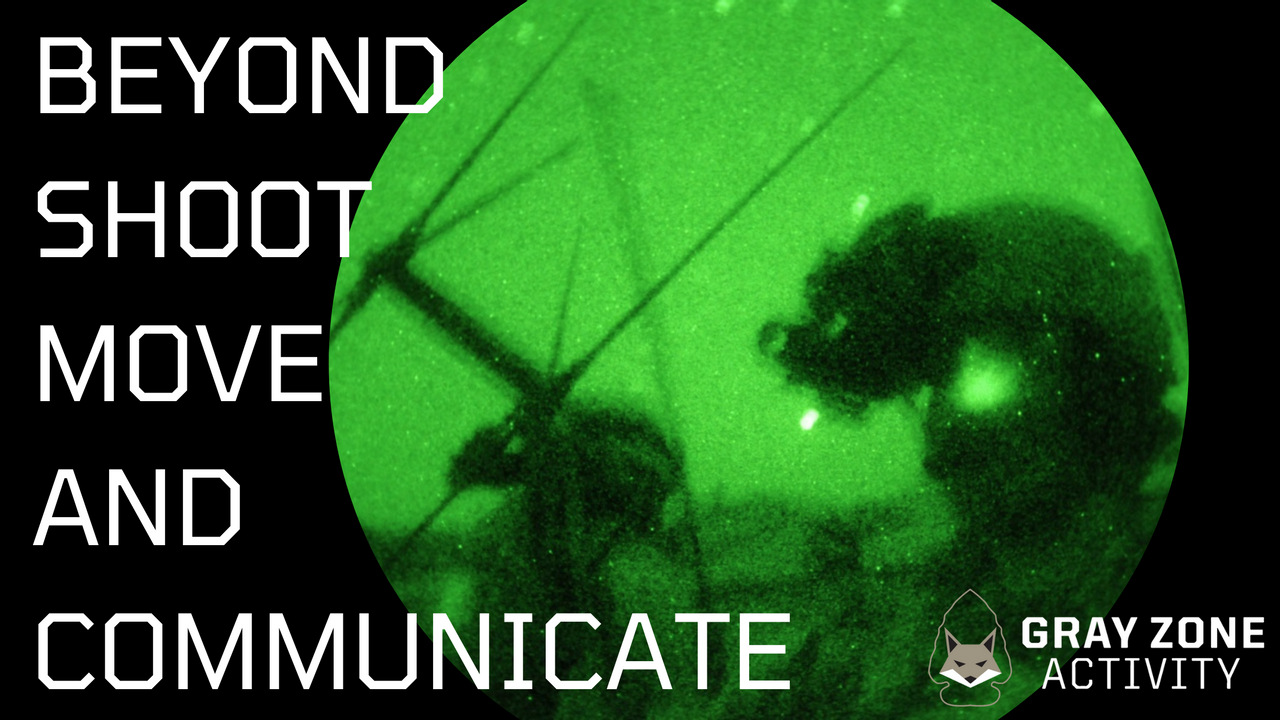Beyond Shoot, Move, and Communicate
Jul 19, 2021
Welcome to the Gray Zone Activity Blog, where we focus on "layer two" preparedness solutions. If you're ready to move beyond fire starters and bug out bags, here's a good place to start.
Several years ago, Army components began using six capabilities as a baseline for skills and readiness. They moved beyond Shoot, Move, Communicate and added Medicate, Sustain, and Decontaminate.
There are a couple of things that make this shift an important one. First, future battlefield conditions dictate that Soldiers, Sailors, Airmen, and Marines will have to do more themselves, likely without the long logistical trains we've seen in prior conflicts. The future battlefield in a high end conflict against a peer competitor will be much more lethal than anything we've seen since World War II. This reality is driving the military's modernization plans right now.
Second, you may have noticed that Intelligence (or Inform) is missing from these six capabilities. That's because intelligence should happen at every level for every capability.
Intelligence doesn't just track changes to the enemy situation, but also changes in other conditions such as Physical Terrain & Weather, the Human Terrain, and Critical Infrastructure to name a few.
The battlespace is 24/7. Changes to the enemy situation and battlespace conditions can occur at any time, which makes the Intelligence effort persistent. The infantry is not always maneuvering and fighting. The medics are not always medicating. Troops are not always communicating. But Intelligence has to happen around the clock. (That's my best guess as to why Inform is missing from these capabilities, be it a mission-critical capability itself.)
Things brings us to the main point: there's a corollary here for preparedness, which I'll list below. Most are probably already familiar with the first three:
+ Shoot: Proficiency in self-defense tactics and tools.
+ Move: Physical fitness and mobility will be key to your survival.
+ Communicate: Transmitting information -- everything from hand signals to High Frequency -- is vital.
And then there are the other three, which deserve some attention.
+ Medicate: Fairly obvious, but one challenge has been figuring out how to Medicate during sustained emergencies without access or availability to hospitals. Most of us can stop an arterial bleed for long enough to get someone to a hospital, but you may need your own long term and critical care solution. This might be the prepper version of a field-expedient hospital, but it almost certainly involves trained nurses and physicians. If medical care becomes disrupted, either due to Gray Zone conflict or a long term or catastrophic emergency, people are going to die from what would otherwise be common cuts and injuries. Historians say that most Civil War deaths were due to uncontrolled infectious diseases, not battlefield wounds. While immediate trauma care, via Stop the Bleed or TCCC, receives attention, longer term healthcare solutions are a massively overlooked capability.
+ Sustain: This is more than beans, bullets, and band-aids. This includes provisions for shelter, fuel, parts, gear, and just about anything else required for ongoing survival. Things break. Sometimes mission-critical vehicles and gear breaks. The ability to repair or replace will be vital to our Gray Zone mission. One reason why I'm interested in 3D printing is because printing spare parts on-demand will fill a large capability gap here.
+ Decontaminate: As I mentioned above, infectious diseases were responsible for two-thirds of Civil War deaths. Do we have a quarantine plan? Do we have the ability to sustain that quarantine? There's been a fair amount of focus on combating post-SHTF illness and disease, and we now have the benefit of having been through a pandemic. There will be another one, and the risk rises exponentially during a sustained emergency. Frankly, every preparedness group (or mutual assistance group or whatever group you have) should have a subject matter expert on Chemical, Biological, Radiological, and Nuclear (CBRN) mitigation and preparedness. Make that person responsible for developing a decontamination plan, and ensure the entire group knows where they fit in. Given the high likelihood that a weaponized virus was just unleashed on the world, it would be foolish not to be preparing for another one.
If you haven't already, it's imperative that you conduct an Area Study and look at threats, conditions, and events that could affect the above capabilities. Much of what you find during your Area Study will inform you of future conditions, and you can be better prepared by understanding what's more and less likely for your area.
Until next time, be well.
Always Out Front,
Mike Shelby

